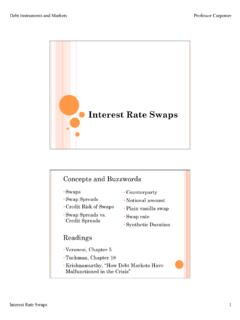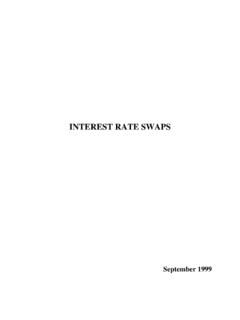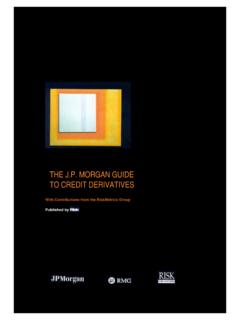Transcription of Inflation Derivatives Explained - the
1 Inflation Derivatives ExplainedMarkets, Products, and PricingFixed IncomeQuantitative ResearchJuly 2005 The Inflation Derivatives market has achieved critical mass, with an outstanding notional volume of over $100bn Inflation Derivatives make it possible to isolate Inflation risk from interest rate risk Zero-coupon Inflation swaps dominate the market and form the building blocks for other Inflation Derivatives Real returns, breakeven Inflation and seasonality are Explained The mechanics, risks and uses of Inflation Derivatives are discussed ISDA 2005 Inflation definitions are outlinedJeroen KerkhofLehman Brothers | Inflation Derivatives Explained July 2005 1 CONTENTS 1. Introduction 3 2. The Markets 5 Growth and size ..5 Market Market participants .. 6 Products overview .. 8 3. Inflation Indices 9 Euro 9 France .. 10 United Kingdom .. 11 United Other Seasonality in Inflation 12 4. Inflation Basics and Concepts 16 Inflation , nominal value and real value.
2 16 Inflation -linked cashflows and real bonds .. 16 Indices, indexation lags and announcements .. 19 Breakeven Inflation .. 21 Components of breakeven Inflation 23 5. Zero-coupon Inflation swaps 25 6. Inflation Analysis Framework 29 Constructing an Inflation curve .. 29 Inflation and interest rate risk .. 34 Counterparty risk .. 36 Rounding risk .. 38 Seasonality Institutional 7. Inflation swaps and Futures 41 Revenue Inflation swap .. 42 OTC Inflation 43 Period-on-period Inflation 43 Inflation asset 45 Inflation futures ..49 Please see important analyst certification(s) on the back page of this report Lehman Brothers | Inflation Derivatives Explained July 2005 2 8. Inflation Volatility Products 52 Inflation caps and floors .. 52 Inflation swaptions .. 53 LPI swaps ..56 Inflation spread options .. 57 9. Structured Inflation Products 59 Total return swaps .. 59 Inflation -linked equity .. 61 Inflation -linked equity options.
3 61 Inflation -linked credit default swaps .. 62 Inflation -linked 64 10. Legal, Regulatory, and Accounting Issues 66 ISDA Inflation Derivatives documentation .. 66 Regulation for pension 67 Accounting standards .. 67 Appendix 69 Calculating Inflation asset swap spreads .. 69 Estimation of seasonal patterns .. 70 Duration and convexity 71 Valuation of forward starting zero-coupon swaps .. 72 Valuation of Inflation caps and 73 Valuation of spread options and Inflation -linked equity options .. 73 Valuation of Inflation 74 References 75 Glossary 76 Summary of Notation and Definitions 79 Lehman Brothers | Inflation Derivatives Explained July 2005 3 1.
4 INTRODUCTION1 In recent years the market for Inflation -linked derivative securities has experienced considerable growth. From almost non-existent in early 2001, it has grown to about 50bn notional traded through the broker market in 2004, double the notional traded through the broker market in 2003. Rapid growth is expected to continue for the coming years. So far the growth has mainly been driven by the European market, but recently interest in the US market has picked up as well. The primary purpose of Inflation Derivatives is the transfer of Inflation risk. For example, real estate companies may want to shed some of their natural exposure to Inflation risk, while pension funds may want to cover their natural liabilities to this risk. In their simplest form, Inflation Derivatives provide an efficient way to transfer Inflation risk. But their flexibility also allows them to replicate in derivative form the Inflation risks embedded in other instruments such as standard cash instruments (that is, Inflation -linked bonds).
5 For example, as we will see later, an Inflation swap can be theoretically replicated using a portfolio of a zero-coupon Inflation -linked bond and a zero-coupon nominal bond. As is the case for the nominal interest rate market, the advantage of Inflation derivative contracts over Inflation bonds is that Derivatives can be tailored to fit particular client demand more precisely than bonds. With the introduction of unfunded Inflation -linked products, Inflation Derivatives have for the first time separated the issue of funding from Inflation risk. This has made Inflation markets more accessible to parties with high funding costs and made it cheaper to leverage Inflation risk. For instance, hedge funds are increasingly involved in Inflation markets. Before any participant enters the Inflation Derivatives market, a solid understanding of the mechanics, risks and valuation of Inflation Derivatives is essential.
6 The aim of this report is to provide this understanding . We hope that readers will gain the necessary comfort and understanding to take advantage of the new opportunities that the Inflation Derivatives market presents. This report is structured as follows. Chapter 2 introduces the reader to the Inflation market by presenting an overview of the market s growth, products and participants. It explains how the market developed and helps readers understand the likely future evolution of the Inflation -linked bond and Inflation Derivatives markets. Chapter 3 discusses the main indices used in both the Inflation cash and Derivatives market. Furthermore, it discusses seasonal patterns in Inflation time series. Chapter 4 discusses the basics of Inflation markets. It explains key concepts such as real returns, real bonds, breakeven Inflation and indexation lags. Chapter 5 introduces the main Inflation derivative security, the zero-coupon Inflation swap.
7 The zero-coupon Inflation swap can be used as a building block for almost all other Inflation Derivatives . Chapter 6 discusses the Inflation risk framework. The chapter shows how to construct an Inflation curve from zero-coupon Inflation swaps incorporating seasonality effects. It also looks at Inflation , interest rates , counterparty, rounding, seasonality and institutional risk. Chapter 7 discusses the plain vanilla Inflation Derivatives products. The most common are Inflation swaps , in their various forms, and asset swaps on Inflation -linked bonds a key link between cash and derivative securities. Investors who participate in the Inflation 1 The author thanks Albert Brondolo, Robert Campbell, Giada Giani, Borut Miklavcic, Alvaro Mucida, Dominic O Kane, Yan Phoa, Rami Shakarchi, and Fei Zhou for valuable comments and discussions. The purpose of Inflation Derivatives is the transfer of Inflation risk Inflation Derivatives allow for tailor-made solutions Our focus is on explaining the mechanics, risk and valuation of Inflation Derivatives Jeroen Kerkhof +44 (0)20 7102 3981 Lehman Brothers | Inflation Derivatives Explained July 2005 4 cash market stand to lose a valuable source of information if they do not understand the Derivatives market, and vice versa, as the two markets are intimately related.
8 We also discuss the recent Inflation futures market. Chapter 8 considers Inflation products with optionality, such as caps, floors and swaptions. We also discuss LPI swaps which have an option-related payoff. Chapter 9 discusses more complex derivative structures, including some hybrid structures. This is relatively unexplored territory in the Inflation world, and is still driven exclusively by client specific needs. However, interest in these more advanced derivative securities is growing and they are likely to be the next area of growth of the Inflation market. Finally, Chapter 10 discusses the standardisation and definitions of the products by ISDA. Furthermore, it considers the influence of regulation and accounting standards on the Inflation market. Lehman Brothers | Inflation Derivatives Explained July 2005 5 2. THE MARKETS Growth and size The Inflation Derivatives market has grown from an almost non-existent and fairly exotic branch of the interest rate market to a sizeable market with substantial growth potential.
9 The pace of this growth has been swift. This is evidenced by inter-dealer data on notional volumes traded (Figure ). Volume doubled in 2004 to about 50bn from about 25bn in 2003. Note that these numbers exclude swaps between banks and their clients, for which the volume is difficult to estimate. The rapid pace of this growth in the past few years is partly attributable to the favourable macroeconomic environment. Historically, low returns on traditional fixed income products and a reluctance on the part of investors to take on risk in the form of other assets led to a rapid growth in demand for structured products in 2003, as can be seen in Figure Figure Monthly volumes of Inflation swaps traded in the broker market bn Source: ICAP; Lehman Brothers. The graph also includes non-Euro swaps . Figure Gross issuance of structured Inflation -linked notes (excluding sovereigns) Oct-99 May-00 Dec-00 Jul-01 Feb-02 Sep-02 Apr-03 Nov-03 Jun-04 Jan-05 bn Source: Dealogic Bondware; Lehman Brothers.
10 However, even though the market has been growing rapidly, it still represents only a small portion of the total rates market. Current volumes of Inflation swaps amount to about 1-2% of nominal interest rate swap volumes. For the Inflation Derivatives market to grow further, it will need to find a balance between demand and supply of Inflation . Inflation swap volumes in the broker market have doubled in 2004 Notionals in the Inflation market are currently at about 2% of notionals in the interest rates market Lehman Brothers | Inflation Derivatives Explained July 2005 6 This is clear by looking at the different markets. Five-year Inflation swaps currently trade with a 2-3bp bid-offer spread in the European market as demand to receive Inflation is strong and Inflation can be sourced from the European Inflation -linked bonds issued by France (OAT i) and Italy (BTP i). With these sovereigns increasing the percentage of their debt portfolio linked to Inflation , it is likely that the Inflation swap market will develop further.









